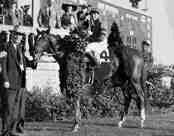That May, he went to Hollywood Park for the California Stakes. Many worried about the burdensome weight of 130 pounds that he was required to carry, but it didn't affect his performance; he won by five lengths.
Because of his victory, he was then required to carry 132 pounds in the Hollywood Gold Cup. In that race, he met the Italian champion Sirlad, who forced Affirmed to run at a tremendous pace considering his burden. Affirmed managed to hold the lead long enough to win by three-quarters of a length and to run the race in 1:58 2/5, missing the American record for that distance by only 1/5 of a second.
Affirmed rested for two months following his victory in the Hollywood Gold Cup before going to New York to win two more races. However, trainer Laz Barrera kept him out of the Marlboro Cup since he was assigned 133 pounds, while the young champion Spectacular Bid was assigned only 126 pounds. He did race in the Jockey Club Gold Cup, though. Each horse was weighted according to its age.
 |
| Affirmed won the Jockey Club Gold Cup after battle for first place with several different horses, including Spectacular Bid.(credit) |
The race was incredible! All throughout, many horses moved forward to challenged him for first place, including Coastal, the 1979 Belmont Stakes winner, and Spectacular Bid, who challenged him four times. Affirmed won in the end, but Spectacular Bid was far from disgraced. Few horses can repeatedly challenge the leader like he did and not come close to last.
Affirmed retired after that. He had earned a grand total of $2,393,818 in his lifetime, was made the world's Current Leading Money Winner until Spectacular Bid took his place in June 1980, and once more earned Horse of the Year honors. This time, no one questioned whether he deserved the title or not; he had proved himself many times that year.
He first served as a stud horse in Spendthrift Farm, the Calumet, and finally Jonabell, where he passed away in January 2001.
Some racing fans believe he failed as a stud horse since he never duplicated himself at stud. Despite those beliefs, he actually sired several noteworthy horses, including Peteski, winner of the Canadian Triple Crown; Charley Barley, the successful Canadian turf racer who earned $922,943; Bint Pasha, who became France's 1987 Champion Three-Year-Old Filly; Tibullo, who was successfully enjoyed his career in Italy; Easy to Copy, who won in Ireland; Trusted Partner, winner of Irish One Thousand Guineas; Buy the Firm, a good handicap mare; and the mare Flawlessly, who won the Eclipse Reward twice and earned over $2,000,000 while under the racing colors of Harbor View Farm, the same as her sire.












































